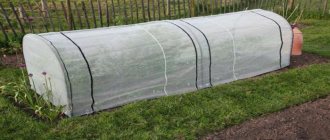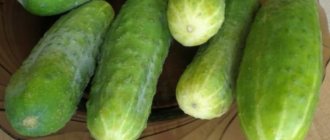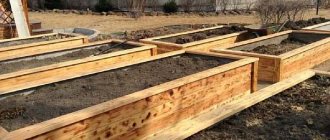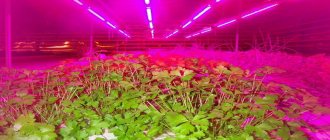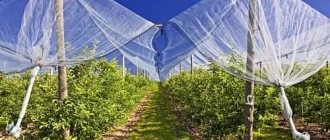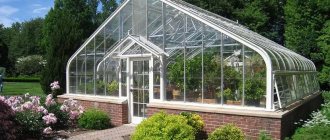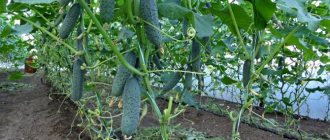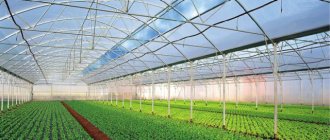Every summer resident strives to ensure that only abundant, tasty and healthy crops grow on his plot. The quality and quantity of fruits depends not only on the skill of the gardener, but also on the structure that carefully protects tomatoes, cucumbers, and eggplants from severe weather, temperature changes and other unpleasant factors.
Usually, when building a greenhouse, a natural question arises - what material is the best greenhouse material? If you do not find the correct answer, then there is a risk of losing money spent on material for greenhouses, as well as precious time spent on an “unsuccessful” harvest.
So, in this useful article we will try to choose the best material for a greenhouse, which will help create a reliable structure for an ideal harvest.
III place - film
This is one of the most popular covering materials, familiar since Soviet times. Easy to install, lightweight, cheap - it would seem, what is not an ideal material for greenhouses and greenhouses?
But more and more summer residents are abandoning this option every year. The thing is that the film has to be re-stretched every year due to its poor resistance to UV rays (because of this, the material loses light transmittance), which means constantly investing money and time. In addition, unreliability and generally low durability only contribute to this grueling procedure.
In severe weather conditions - strong winds and heavy hail and hot sun - the film may not withstand even one season.
It is also worth noting that polyethylene film (usually thicknesses from 0.1 mm to 0.15 mm are used) is not suitable for year-round cultivation of crops, since it easily gives off heat. Also, condensation can constantly form on the film, thereby creating optimal conditions for the growth of unwanted microorganisms and fungi.
Which film is better for a greenhouse? For example, there are some types of films with an increased service life:
- Reinforced
- a film with a frame that takes on some load. The average service life of the product is 2-3 years. A reinforced film with a density of 120 - 200 g/sq.m. is suitable as a covering material for a heifer. m. - Polyvinyl chloride
is an elastic and relatively reliable film, similar to the material from which medical droppers are made. It has good transparency, does not allow the greenhouse to cool down quickly at night, and can last 3-4 seasons. The downside is that such film is several times more expensive than regular polyethylene film, but it is worth considering that it does not have to be changed every year. Dust also easily sticks to it, constantly contaminating the material and reducing light transmission. In addition, the film will constantly have to be tightened due to sagging, which, thanks to strong winds, will quickly turn into tears. - Improved polyethylene
- among these special films we can note stabilized (increased resistance to UV radiation), light-transforming (converts ultraviolet into infrared and red radiation), as well as heat-retaining and stabilized. The service life of such covering materials will be slightly longer - up to 3 years.
Reinforced PVC film M-Tex Crystal, width 2 m
enough
32.02 BYN /mp
More details
In general, we can conclude that any film is more suitable for a temporary solution. For a serious greenhouse that regularly produces good, healthy and tasty harvests, pleasing with its performance characteristics, such material is unlikely to be suitable.
Summer residents will argue about which film to choose for the greenhouse for many years to come. We will move on to the next no less popular option.
Greenhouse made of film
This material replaced glass in the mid-twentieth century; many generations of summer residents trusted it with their harvest for a long time, and even now it has its fans. For many years, polyethylene film had no equal as a covering material for greenhouses. The film transmits light well , it is light, inexpensive, and easy to handle. But there is also another side to the coin. This polymer material is short-lived. When exposed to sunlight and high temperatures, it quickly deteriorates. It is only enough for one planting season, which is only three to four months . Improved film analogues are now being produced, the service life of which has been extended by several years. Such polyethylene is usually used for several seasons, without even removing it for the winter. It tolerates temperature changes well, is much stronger and more durable.
There is no condensation in a greenhouse covered with such a film; it retains heat better, and the increased density protects plants from ultraviolet radiation. This effect was achieved thanks to the addition of special light stabilizers and absorbents during production. All this allows you to maintain a favorable regime for plants.
A polypropylene film can last three to four years . At the same time, it allows not only light to pass through, but also air and water, which simplifies the care of plants.
There is another film option - hydrophilic . Its surface does not become as dirty as a regular film. And the evaporating water flows down without harming the plants. This material will last two to three years.
In a greenhouse with heat-retaining film, the temperature will be several degrees higher, which will make it possible to get the harvest earlier.
2nd place - glass
Ordinary glass can be considered an equally traditional material. Often, summer residents build greenhouses from old window frames, which cannot be called a reliable and technologically advanced option. Yes, such a greenhouse can last for many years and it will not lose its former transparency, but this option has plenty of disadvantages.
The main disadvantages include significant mass, requiring a powerful frame. The abundance of structural elements will contribute to the darkening of plants, which will not have a beneficial effect on growth. In addition, a glass greenhouse necessarily requires a foundation and constant monitoring of joints for leaks.
Also, all work in and around the greenhouse must be carried out very carefully, since the risk of damage to the glass is quite high, and along with this, damage to the plants due to fragments will follow. Along with this point, the main risk of using glass is hail, which can easily break the product.
A significant drawback that forces greenhouse lovers to abandon this option is its high thermal conductivity. A glass structure will heat up quickly during the day and cool down just as quickly at night, which has an extremely negative impact on crop growth. Another disadvantage is that glass does not have UV protection, the light is not scattered and plants get burned.
Difficulties may also arise at the installation stage, which will require certain equipment and skills. If you do not know how to process glass, you will have to turn to specialists.
One of the advantages is that the material does not emit a smell that negatively affects plants due to exposure to sunlight.
Rarely found glazing materials.
Let's briefly talk about materials that are not included in the main list, but are worthy of mention. On the plot of an enthusiastic summer resident you can find a greenhouse made of plastic and glass containers. The thermal insulation properties, as well as the tightness of such projects, are extremely doubtful, although finding an inexpensive suitable material will not be difficult. And it won’t take a lot of effort and money to build.
It is possible to improve a greenhouse made from plastic bottles using a needle and thread. Pieces of cut bottles are sewn together to form a large sheet of plastic. Which is subsequently laid on any available frame. It is worth considering that creating this canvas takes a lot of time, and therefore is suitable for those who have nothing to do on long winter evenings.
It is much easier and faster to wrap the frame with stretch film - it is sold in any supermarket. Therefore, you should not expect from a greenhouse for 2 thousand rubles. (about how much the material will cost) strength and durability. You will have to rewind the frame quite often.
1st place – cellular polycarbonate
Cellular polycarbonate is a polymer plastic that includes several layers with an air gap provided by stiffening ribs. It is this layer that guarantees low thermal conductivity, allowing the use of a polycarbonate greenhouse all year round.
Millions of summer residents are abandoning previous options for roofing materials in favor of cellular polycarbonate due to its great durability (manufacturers provide a 10-year guarantee), reliability, and relatively simple installation. In addition, the following significant advantages can be noted:
- The material is 200 times stronger and lighter than glass.
- It is not afraid of harsh weather conditions - hail, downpours, strong winds.
- 4 mm polycarbonate sheets are comparable in thermal conductivity to double-glazed windows.
- One side of the polycarbonate has UV protection.
- Light transmitted through polycarbonate will not cause burns (unlike glass).
- Does not require special care.
Regular 4 mm cellular polycarbonate can withstand frost, so it is ideal for growing plants in winter.
In order for the material to serve in the greenhouse for many years (if not decades), it is necessary to use special fasteners and strips.
It is worth considering that in summer the temperature in a greenhouse made of cellular polycarbonate can reach 50-55 °C, so the room must be equipped with windows for ventilation.
One of the disadvantages is low resistance to aggressive chemicals, so you can only care for polycarbonate with a regular solution of soapy water and a sponge. It is also necessary to install a foundation under the structure, which may complicate the possible transfer of the greenhouse.
Greenhouse polycarbonate transparent, 6 mm, density 0.69, 6000x2100 mm
we will order for you
Price on request
More details
Greenhouse polycarbonate transparent, 4 mm, density 0.46, 6000x2100 mm
we will order for you
Price on request
More details
Greenhouse polycarbonate transparent, 4 mm, density 0.48, 6000×2100
we will order for you
Price on request
More details
Greenhouse polycarbonate transparent, 4 mm, density 0.42, 6000×2100
we will order for you
Price on request
More details
Requirements for covering material
When planning construction, owners especially carefully choose what to cover the greenhouse with. The thoroughness of the search is clear: the future harvest largely depends on the properties of the thin shell. It will also affect the appearance of the building, its cost and operating parameters (including maintenance).
Each material has its own set of qualities; knowledge of their advantages and disadvantages will help you make a practical choice suitable for specific conditions. The materials used to cover greenhouses and greenhouses are not very similar to each other; their only common property is transparency. However, for all of them it is highly desirable to have the following characteristics:
- Strength. Both the resistance of the material to random mechanical loads and to weather vagaries, from wind and rain to snow and hail, are important. Strength determines the service life of the material.
- Light transmission (especially in the ultraviolet part of the spectrum) and the degree of light dispersion. It is these properties that provide the desired greenhouse effect and allow you to save on lighting.
Light transmission is the main quality of a greenhouse building Source amiranxxi.com.ua
- Thermal insulating properties make it possible to maintain the desired microclimate, save on heating or refuse it in the spring and summer.
- Construction characteristics. Acceptable weight and cost, ease of installation, and flexibility of the material determine the cost of construction and the possibility of making a greenhouse on your own.
- Performance characteristics. The material is resistant to mold, maintainable, easy to care for the surface.
When exploring different options for covering a greenhouse, the owner will have to look for a compromise between several properties. This is the only way to get a structure with a sufficient service life, reasonable cost, and maximum comfort for plants.
It’s easy to make a lightweight greenhouse with your own hands Source express-novosti.ru
And yet, what material should be used for the greenhouse?
In total, what material to choose for the greenhouse depends, of course, on you. You can cover the greenhouse with new film every year, spending your time and money on it.
You can assemble a greenhouse from window frames, but do not be surprised if the plants develop sunburn and, due to the darkening, they are clearly delayed in ripening. Yes, and suddenly falling hail can fray your nerves and damage the crop that you have been so painstakingly caring for.
Or you can invest once in a truly worthwhile purchase, and not worry about the quality of the crop, weather conditions, proper microclimate and other important factors. Cellular polycarbonate in this case is the best choice.
| Films | Glass | Cellular polycarbonate | |
| Life time | 1-4 years depending on the type of film | According to reviews, an average of 5 years | 10 years (longer with proper use) |
| Thermal conductivity | High | High | Low (perfect fit) |
| Weight | Low | High | Low |
| Resistant to harsh weather conditions | Low | Average | High |
| All-season | No | No | Yes |
| Installation | Easy | Obstructed | Easy |
| Price | Low | Average | Average |
Comparison of polycarbonate and Svetlitsa film for greenhouses and greenhouses
Many gardeners do not consider polymer films as an alternative to cellular polycarbonate. And in vain. There are greenhouse films that are superior to polycarbonate in many respects. We are talking, of course, about Svetlitsa! Strength, durability, elasticity, transparency, frost resistance - these are just its main properties for which customers love and appreciate it. And here is the decisive argument - greenhouse plants under Svetlitsa yield more than under polycarbonate! These data were obtained during comparative tests in greenhouses of the St. Petersburg Agrarian University.
Increasing yield under greenhouse film Svetlitsa
All other things being equal, there were 60% more peppers in the greenhouses near Svetlitsa, 30% more cucumbers, and 20% more tomatoes than in the greenhouses under cellular polycarbonate. Both we, the employees of the Shar company, and the agronomists were amazed by the results obtained. However, this is understandable if we once again pay attention to the conditions that are created in greenhouses under polycarbonate - low light, too high temperature and humidity. The question is, why pay more?
To be fair, it must be said that there are happy owners of polycarbonate-covered greenhouses who are satisfied with their purchase. It's up to you, of course, to decide. We hope that our tips will help you avoid mistakes.
If you are interested in Svetlitsa film, then you can see all the detailed information about this greenhouse film here at the link.
Video description
About what depends on the color of the film or polycarbonate in the following video:
Agrofibre
For summer residents and farmers wondering how to cover a greenhouse, an alternative to glass and film is offered - a range of non-woven covering materials. Agrotextiles are made from polymer fibers and are produced under different brands (for example, spunbond, agroslan, agrotex, lumitex) in two types: white and black. White varieties are suitable for covering greenhouses or greenhouses, as well as for open ground. Black ones are used for mulching the soil or, for example, insulating seedlings. Agrotextiles with a density of 30-60 g/m² are suitable for greenhouse farming. Polymer fabric is used as a temporary covering material due to its following advantages:
- Has the ability to pass moisture and air.
- Creates diffused lighting, protects from ultraviolet radiation, and prevents condensation from forming.
- It is inexpensive, weighs little, and is easy to install.
Cons of agrofibre:
- The low thermal insulation of fabric for greenhouses allows it to be used only in the spring and summer.
- High price.
Agrofabric is easy to use Source ekotec.com.ua
Conclusions and recommendations
Everyone should choose the best way to cover the greenhouse independently, taking into account the individual conditions of the area, climate and situation on the territory. The best option for most gardeners is still cellular polycarbonate. It is most optimal for any region of our large country. Before purchasing, you should familiarize yourself with what components are available for this material so that the installation of the structure is correct.
It is difficult to say whether to cover the greenhouse with film. Everything depends, again, on specific conditions. The only thing that remains certain: polyethylene is the best material for one-season greenhouses. A detailed analysis of each of the possible coatings will help you make the right choice. You can think about how to cover the greenhouse after this issue has been resolved.

